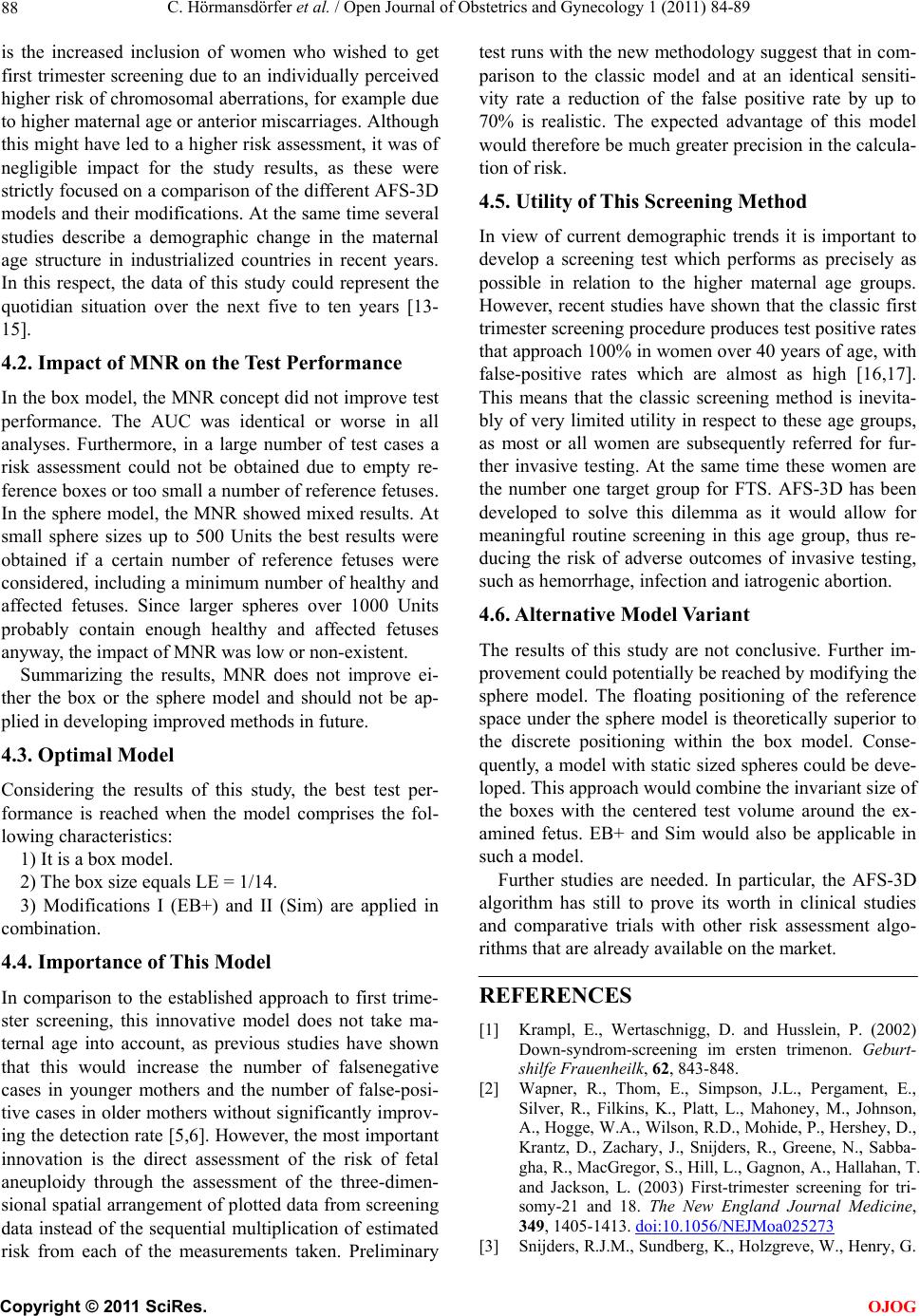
C. Hörmansdörfer et al. / Open Journal of Obstetrics and Gynecology 1 (2011) 84-89
88
is the increased inclusion of women who wished to get
first trimester screening due to an individually perceived
higher risk of chromosomal aberrations, for example due
to higher maternal age or anterior miscarriages. Although
this might have led to a higher risk assessment, it was of
negligible impact for the study results, as these were
strictly focused on a comparison of the different AFS-3D
models and their modifications. At the same time several
studies describe a demographic change in the maternal
age structure in industrialized countries in recent years.
In this respect, the data of this study could represent the
quotidian situation over the next five to ten years [13-
15].
4.2. Impact of MNR on the Test Performance
In the box model, the MNR concept did not improve test
performance. The AUC was identical or worse in all
analyses. Furthermore, in a large number of test cases a
risk assessment could not be obtained due to empty re-
ference boxes or too small a number of reference fetuses.
In the sphere model, the MNR showed mixed results. At
small sphere sizes up to 500 Units the best results were
obtained if a certain number of reference fetuses were
considered, including a minimum number of healthy and
affected fetuses. Since larger spheres over 1000 Units
probably contain enough healthy and affected fetuses
anyway, the impact of MNR was low or non-existent.
Summarizing the results, MNR does not improve ei-
ther the box or the sphere model and should not be ap-
plied in developing improved methods in future.
4.3. Optimal Model
Considering the results of this study, the best test per-
formance is reached when the model comprises the fol-
lowing characteristics:
1) It is a box model.
2) The box size equals LE = 1/14.
3) Modifications I (EB+) and II (Sim) are applied in
combination.
4.4. Importance of This Model
In comparison to the established approach to first trime-
ster screening, this innovative model does not take ma-
ternal age into account, as previous studies have shown
that this would increase the number of falsenegative
cases in younger mothers and the number of false-posi-
tive cases in older mothers without significantly improv-
ing the detection rate [5,6]. However, the most important
innovation is the direct assessment of the risk of fetal
aneuploidy through the assessment of the three-dimen-
sional spatial arrangement of plotted data from screening
data instead of the sequential multiplication of estimated
risk from each of the measurements taken. Preliminary
test runs with the new methodology suggest that in com-
parison to the classic model and at an identical sensiti-
vity rate a reduction of the false positive rate by up to
70% is realistic. The expected advantage of this model
would therefore be much greater precision in the calcula-
tion of risk.
4.5. Utility of This Screening Method
In view of current demographic trends it is important to
develop a screening test which performs as precisely as
possible in relation to the higher maternal age groups.
However, recent studies have shown that the classic first
trimester screening procedure produces test positive rates
that approach 100% in women over 40 years of age, with
false-positive rates which are almost as high [16,17].
This means that the classic screening method is inevita-
bly of very limited utility in respect to these age groups,
as most or all women are subsequently referred for fur-
ther invasive testing. At the same time these women are
the number one target group for FTS. AFS-3D has been
developed to solve this dilemma as it would allow for
meaningful routine screening in this age group, thus re-
ducing the risk of adverse outcomes of invasive testing,
such as hemorrhage, infection and iatrogenic abortion.
4.6. Alternative Model Variant
The results of this study are not conclusive. Further im-
provement could potentially be reached by modifying the
sphere model. The floating positioning of the reference
space under the sphere model is theoretically superior to
the discrete positioning within the box model. Conse-
quently, a model with static sized spheres could be deve-
loped. This approach would combine the invariant size of
the boxes with the centered test volume around the ex-
amined fetus. EB+ and Sim would also be applicable in
such a model.
Further studies are needed. In particular, the AFS-3D
algorithm has still to prove its worth in clinical studies
and comparative trials with other risk assessment algo-
rithms that are already available on the market.
REFERENCES
[1] Krampl, E., Wertaschnigg, D. and Husslein, P. (2002)
Down-syndrom-screening im ersten trimenon. Geburt-
shilfe Frauenheilk, 62, 843-848.
[2] Wapner, R., Thom, E., Simpson, J.L., Pergament, E.,
Silver, R., Filkins, K., Platt, L., Mahoney, M., Johnson,
A., Hogge, W.A., Wilson, R.D., Mohide, P., Hershey, D.,
Krantz, D., Zachary, J., Snijders, R., Greene, N., Sabba-
gha, R., MacGregor, S., Hill, L., Gagnon, A., Hallahan, T.
and Jackson, L. (2003) First-trimester screening for tri-
somy-21 and 18. The New England Journal Medicine,
349, 1405-1413. doi:10.1056/NEJMoa025273
[3] Snijders, R.J.M., Sundberg, K., Holzgreve, W., Henry, G.
C
opyright © 2011 SciRes. OJOG